
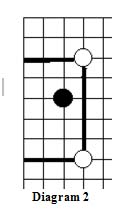
Diagram 1 When B2 approaches W1, the squeeze play of W3 is particularly effective because ...
Diagram 2 Now the lone Black stone is enclosed within the indicated White Sector Lines, as both players would visualize them.
|
A Sector Line Is An Imaginary Straight Line Extending Across An Open Board Area Joining Two Stones Of The Same Color, Or Extending From A Single Stone To The Board Edge. |

|

|
Diagram 1 When B2 approaches W1, the squeeze play of W3 is particularly effective because ... Diagram 2 Now the lone Black stone is enclosed within the indicated White Sector Lines, as both players would visualize them. |

|
Diagram 3 When B1 is played, it breaks the outer Sector Line and negates it, so that Black is no longer enclosed! |
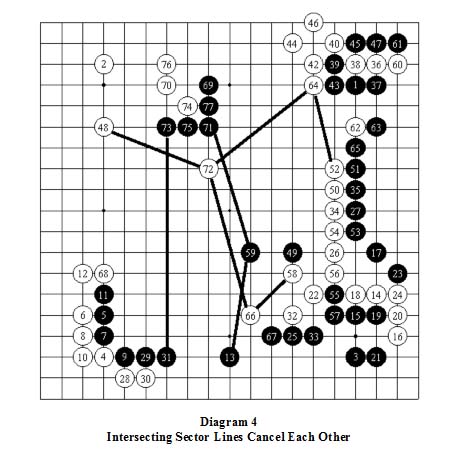
|
Diagram 4 Here we see that W72 is within Black Sector Lines, but Black’s 69-77 group is similarly enclosed by White Sector Lines which intersect Black’s. The two B49, 59 stones are within White Sector Lines, but are also an anchor point of the Black Sector Lines which enclose W72. The result is that none of these Sector Lines are valid for determining the appropriate action to be taken in this area. This sort of situation is quite common when the board becomes relatively crowded, but in no way detracts from the general utility of the Sector Line concept. |
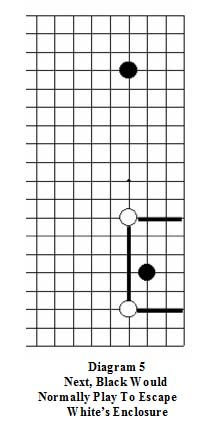
|
Diagram 5 The position in the lower right corner begins with the same popular 3-4 point Joseki we saw earlier in Dia 1, in which White has just squeezed the lone Black stone from above, enclosing it within the indicated Sector Lines. These Sector Lines are close enough to constitute a fairly serious threat, so under normal circumstances Black would respond immediately. But because this 9P Black calculated that he can still readily live locally even if White is first to play again here, he instead chose to take Sente elsewhere. Although this was a rational global strategic decision, it gave White the opportunity to maximize his local advantage, as we see in the following diagrams. |

|
Diagram 6 W1 takes advantage of Black’s failure to defend by blocking him from the corner, making territory for White while making it harder for Black to secure eyespace locally. If White were to be allowed to continue at 2 next , that would not only make perfect shape for his own stones but would also make it extremely hard for the Black stone to make life locally. So with little choice, B2 occupies the key shape point himself, while cutting the White Sector Line! (A strong clue that this is a desirable move!) A (slightly lesser) problem with B2 is that it also makes his unit “heavy”. W3 With this stylish Knight’s move extension, White increases the scope of his control of the corner by extending to the left, at the same time creating a new Sector line which once again encloses Black.(thereby maintaining Sente!) |
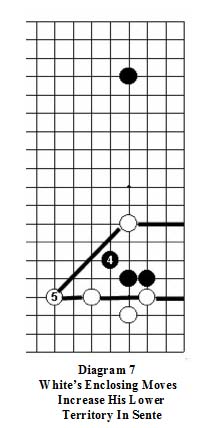
|
Diagram 7 In order to escape that enclosure it’s necessary to break White’s new Sector Line, and in this position the stylish diagonal extension of B4 is the best way to achieve this end. An alert reader will have noticed that B4 not only broke the White Sector Line but also established Black’s own Sector Line enclosing the lone White stone on the right side. But because the Black star point stone anchoring the upper end of that Sector Line is so far away, the lone White stone is only mildly affected by this. So for the moment White can afford to ignore that Black Sector Line, to continue his own attack. White’s natural response to B4 is to extend once again on the bottom with the one point skip of W5, increasing his local territory while also initiating the new Sector Line shown, to once again enclose the 3 Black stones. |
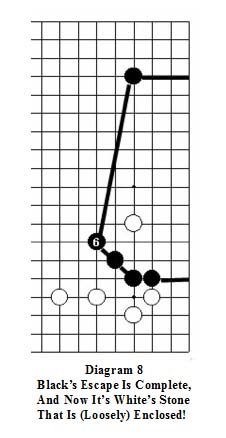
|
Diagram 8 When B6 breaks the latest White Sector Line, there is no further White move that will simultaneously enclose the Black stones within a new White Sector Line while also extending White’s lower side territory. That means that, for the moment at least, it is no longer profitable for White to continue playing on the lower side, because it would be Gote. On the other hand, we see that Black has now established his own Sector Line enclosing White’s lone right side stone. But because the upper anchor stone of this Black Sector Line is so distant, this lone White stone has more than ample maneuvering room to either make a base or escape into the center if attacked further. So the Sector Line analysis tells us that White can now afford to play elsewhere if his evaluation of the global board position indicates that would be more productive - and that in fact is what the 9 Dan pro playing White in this game actually did! |
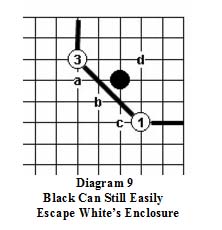
|
Diagram 9 This is a situation that frequently arises in both even and handicap games when Black fails to respond locally to the kakari of W1. W3 (which is also often played at “a”) encloses the Black corner stone within White Sector Lines as shown. But Black can still easily break out safely via a play at any of “a”, “b”, or “c”. But if he doesn’t ... |

|
Diagram 10 Most often, White’s strongest continuation is with W1 here, to solidly enclose Black within his Sector Lines. Black can then cut these Sector Lines, but can’t forcibly break out through them. Now let’s examine why allowing W1 is usually bad for Black. |
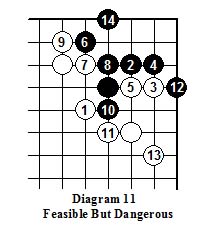
|
Diagram 11 Black can still live in the corner, if he either knows this sequence by heart or can find his way through its tactical complications unaided. But it’s dangerous because even a slight error in the sequence can easily result in the entire corner’s death! And even if Black lives, as here, White’s thickness usually gives him the better position globally. So playing this way is usually only advisable in special circumstances. |

|
Diagram 12 Black will usually be best advised to break out of the White Sector Line, most often by occupying the key point himself via B1 as shown, but sometimes by attaching at “a” or “b”instead. After B1, W2 to seize the corner is by far the most frequent continuation, and then Black will usually (sooner or later) block at either “c” or “d”, the choice depending on the global board position. |
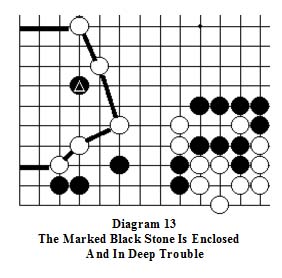
|
Diagram 13 In this game between an 8D and 6D, the marked Black stone is completely enclosed by White Sector Lines, so it appears that all of this large territory is about to become White’s. Living in place is difficult, but Black saw an opportunity to save this stone and neutralize much of White’s potential territory in the surrounding area if he could somehow manage to connect to the Black stones below. The next diagram shows how he went about doing it. |
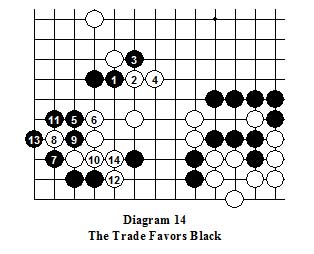
|
Diagram 14 With this clever sequence, Black managed to connect underneath in the lower left and achieve life, thus neutralizing most of this formerly large White area. In return, White captured a part of Black’s former lower edge group, to sharply increase his own territory there. So Black’s gain was not without cost, and that’s a fairly common result of such confrontations. But on balance Black has profited a bit more, at least in part because he has emerged from this fight with Sente. |

|
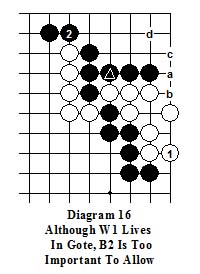
|
Dia 15 In this game between two 7D players, when the marked Black stone was played it not only prevented White’s damaging push through-and-cut, but also completed the enclosure of the White 7-stone group on the right edge. In the absence of special circumstances Black should without fail play to enclose White as shown! Dia 16 If White now desires, his 7 stones on the right edge can live easily via W1, because then if B“a”, W”b” completes his two eyes. And if Black doesn’t play at “a”, it’s possible that at an appropriate later time White will be able to follow with the profitable endgame sequence of W“a”, B“c”, W“b”, B“d”. |
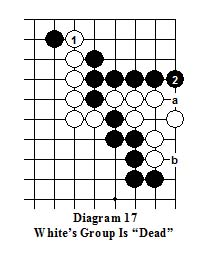
|
Diagram 17 Because the result of Dia 16 was unpalatable, White chose instead to play W1 here, to strengthen the crucial weak 5-stone center White string! This not only undercut the Black corner while preventing Black’s connection underneath, but also isolated the lone Black stone on the upper edge. But the severe price that White had to pay for this was B2, which more or less assures the death of the White right edge group, because now White needs both “a” and “b” to secure his two eyes, and he can only manage that by making two successive moves here. (Only possible if played as a Ko threat which Black can’t afford to answer.) So after B2 White had no choice but to tenuki, and hope that circumstances would later enable him to rescue this “abandoned” 7 stone group on the right edge. |

|
Diagram 18 W4 is a probe intended to induce Black to fix the shape of his stones, so that White will then know how to best proceed locally at the appropriate later time. But as things stand it was too early in the game to be sure after B5 whether White will prefer to continue below, on the right, or on the 3-3 point in the corner, and W4 is enclosed within the indicated close and very threatening Black Sector Lines. So for the moment W4 was correctly “abandoned”, as White played elsewhere! (From that, it might reasonably be argued that W4 was premature and should better have been deferred until a later time. But that's an issue well beyond our present focus.) |
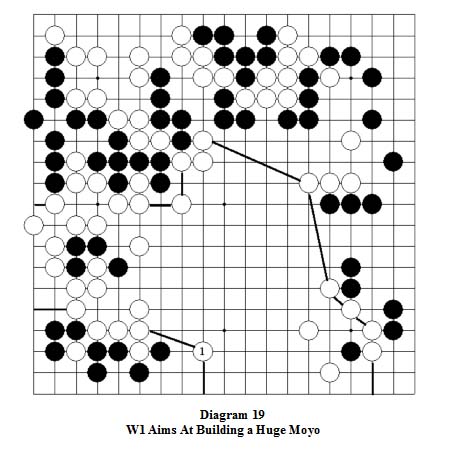
|
Diagram 19 In this game between a 4D and a 3D, when W1 was played it seemed that White had visualized the indicated Sector Lines and the huge potential moyo that they enclose. But, although appearing logical, this reasoning is actually doubly flawed! Not only are there are two Black Sector Lines running from the upper right to the lower left that intersect (and therefore neutralize) several of White’s, but, far more significant, Black can counter-attack by establishing his own far more threatening Sector Lines! |
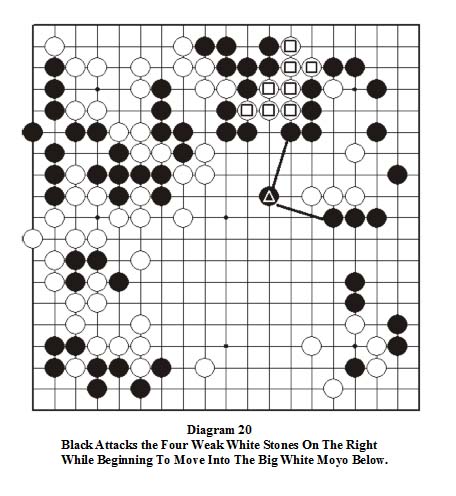
|
Diagram 20 A strong Black response would have been as shown, not only enclosing the 4 weak White stones within the indicated close (and therefore very threatening) Sector Lines of his own, but also simultaneously assuring that Black can move into the White moyo before it can be consolidated. (Note that the 8 marked Whites at the top are tightly enclosed with only 3 liberties, and are therefore effectively captured!) Although the outcome of the fight that would have followed isn’t entirely clear, it would have offered Black his best chance to win. When he failed to make this key play, White moved smoothly on to an easy victory! |
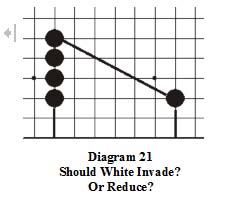
|
Diagram 21 This is a not uncommon situation in which Black has made a 5 point skip from a 4-stone wall based on the third line to form a small moyo, against which White will often feel compelled to act. But how? And where? |
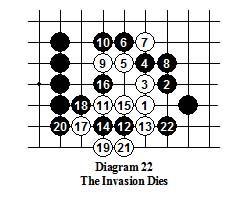
|
Diagram 22 The best try to make a live group within the Black space is to begin with this one point third line skip of W1 from the extension stone. In response, the diagonal extension of B2 is the strongest way to prevent White’s escape to the outside, forcing him to try to live in place. This diagram shows one possible continuation, in which the invasion dies, and the next diagram shows another with the same result. |

|
Diagram 23 The problem in this position with an invasion like this W1. is that there really isn’t room enough for the invaders to live if Black defends correctly! And if White does die, as here, that allows Black to consolidate a territory of over 30 points. |
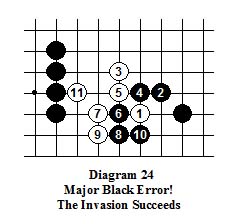
|
Diagram 24 This diagram shows that if Black errs, then White can escape, with a disastrous reduction to what formerly seemed a large potential Black territory. But in at least partial compensation Black now is strong on both sides while the still eyeless Whites remain weak and vulnerable! |

|
Diagram 25 From the foregoing, it’s likely that a prudent White won’t choose to invade but will instead opt for a reduction. For that purpose, W1 as shown here (just breaking the Black Sector Line) or “a” are usually the best moves, the choice between them depending upon the location of other nearby White and Black stones and the tactical considerations they engender. |
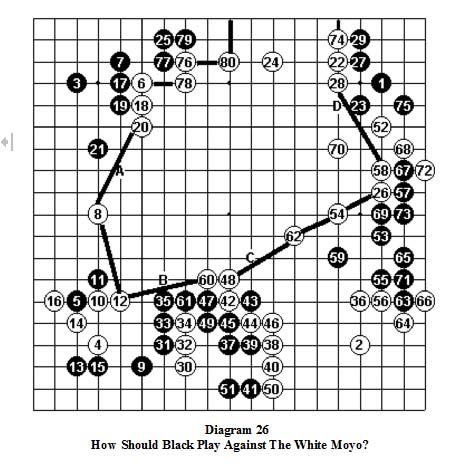
|
Diagram 26 In this position from a game between two 5D players, White has created a large moyo in the upper center which Black must do something to reduce before it can be consolidated into a winning territory! As usual in such situations, the question to be answered is whether Black should invade the moyo and attempt to live within its confines, or try to reduce it by nibbling away at it from somewhere on its outer perimeter. This is the kind of situation in which Sector Lines can often provide the best clue as to which of these courses of action is likely to be the most productive. The major difficulty in this position is that a White Sector Line actually covers each of this moyo’s borders, so that only an invasion is really feasible if Black wants to prevent White from consolidating too much of this vast area. At the same time, we see that there are four places, marked “A”, “B”, “C”, and “D” in which the White Sector Line is long enough and/or Black stones are near enough to it to offer support to an invasion. Such potential places of ingress and/or egress are called “doors”. Here, only doors A and B offer real potential for Black as things now stand. |

|
Diagram 27 Because the main A and B doors capable of exploitation are both on the left side of White’s moyo, it’s clear that Black’s best invasion point must be somewhere in that vicinity, but the choice of B81 as the starting point for Black’s invasion was a judgment call. W82 Rather than simply trying to limit Black’s incursion, White counterattacked by threatening to continue at 83, which would both restrict the expansion of Black’s upper left corner territory while making a sizeable territory of White’s own in that area in conjunction with his stones below. In addition, it blocked Black’s access to door A. B83 Given that door B is still open. and because a White continuation at 83 would be too good to allow, Black felt that he had no choice but to block here himself to seal off his upper left territory. So White retained Sente. W84 similarly blocks off Black’s flight path to door B, leaving Black with the difficult problem of how to continue to achieve life. But now Black’s chances for success are somewhat improved, because he will be able to play a second stone inside White’s moyo before White can respond there. The details of the complex fighting that actually followed in this game are primarily tactical considerations that lie far beyond our focus on learning how to use Sector Lines, so are not presented here. |

|
Diagram 28 W1 encloses the Black lower right corner stone within White Sector Lines. Then, in the absence of any more urgent play elsewhere, it’s to Black’s advantage to respond by expanding/sealing off his eyespace to ensure his life. The defensive attachment of B2 is an excellent, time tested way for Black to achieve safety, and begins a popular Joseki. |

|
Diagram 29 Instead of continuing with the “normal” Joseki move of W11 at 14 to establish a live group along the edge, with this W11 a swap occurred, with Black destroying White’s potential at the bottom in return for White’s effectively killing the 3 Blacks on the left and almost (but not quite) securing the lower left corner! |
|
Look First At The Relative Strength Of The Opposing Groups And Any Sector Lines They Generate |
|
Override Those Indications Only If There Is A Clear And Compelling Reason For Doing So |